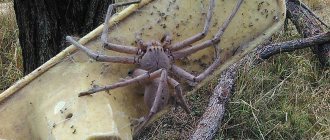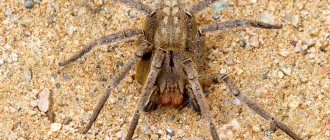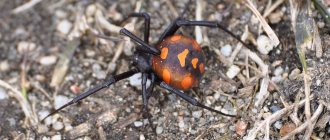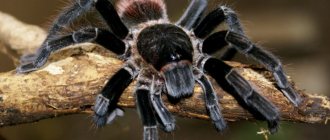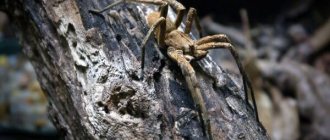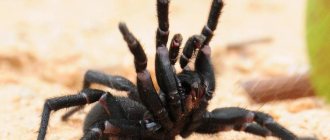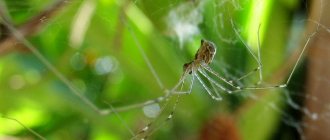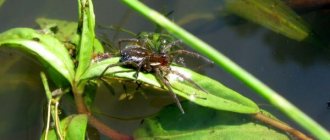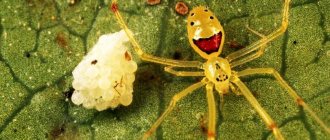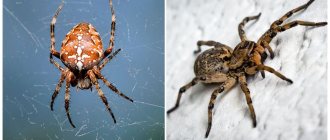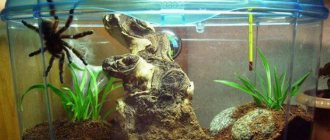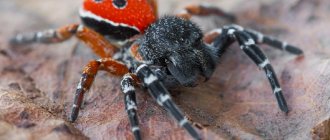- Wild animals
- >>
- Arachnids
The six-eyed sand spider is a medium-sized spider of deserts and other sandy environments in southern Africa. It is a member of the araneomorpha spider family, and close relatives of this spider are sometimes found in both Africa and South America. Its closest relatives are the recluse spiders, which are found throughout the world.
Six-eyed sand spider (Latin: Sicarius hahni)
The six-eyed sand spider is ranked among the top five most dangerous spiders in the world. The toxicity of its venom is in no way inferior to the toxicity of the venom of spiders that are leaders on this list (for example, the Brazilian wandering spider, the leukopachine funnel web spider, shadow spiders).
Six-eyed sand spider (lat. Sicarius hahni) (eng. Six-eyed sand spider). Photo by M.Heule
The six-eyed sand spider belongs to the Sicariidae family and is a close relative of the hermit spiders of the genus Loxosceles.
The habitat of these spiders is sandy areas in southern Africa. Other species from the same family have also been found in South America. They live among sand dunes, hiding under stones, snags, between tree roots, and masterfully bury themselves in the sand.
These spiders are classified as “living fossils” because they inhabited these continents even before the division of the ancient supercontinent Gondwana (which included the territories of modern Africa, South America, Australia and Antarctica), which occurred about 100 million years ago. There are 21 species in the genus Sicarius, most of which are distributed in Africa (Western Cape and Namibia). An interesting fact is that spiders living on the African continent have stronger poison than their South American counterparts.
The six-eyed sand spider is medium in size. The length of its body reaches 8-15 millimeters, and if measured with the span of its legs, then about 50 millimeters. Six eyes. Depending on their habitat, these spiders may be reddish-brown or yellowish in color. Thanks to its flattened body and slightly curved legs, the six-eyed spider looks somewhat like a crab. For which it received another name - the crab spider.
These spiders are very “shy” and try to avoid meeting people. Therefore, the likelihood of meeting them and being bitten is extremely low. There are only 2 known cases in the world where people died from the bite of this spider.
Their venom contains cryotoxin, which is considered one of the most powerful toxins ever discovered in living things. It completely destroys tissue cells, causing ruptures in the walls of blood vessels, which leads to numerous and serious internal bleeding. Unfortunately, an antidote for this poison has not yet been created. Scientists still cannot fully understand how this toxin does not destroy the cells of the internal organs of the spider itself. It is believed that it (the toxin) acts like sulfuric acid.
Sicarius hahni perfectly senses the vibration created by any creature, even the smallest, and when it passes very close, the spider quickly attacks. He immediately injects poison into his victim and waits for it to take effect. You don't have to wait long. The victim dies almost immediately.
Photo by M. Heule
They lay their eggs in a cup-shaped bag woven from adhesive thread and sand particles, which they then bury thoroughly. Egg development occurs over a fairly long period of time.
Photo by M. Heule
Photo by M. Heule
This spider is a vivid example of how to survive under unfavorable living conditions. Well-fed, these spiders can live without food and water for about a year. Their total lifespan can reach 15 years, which is unusual, since most related spiders live no more than 3 years.
Photo by M. Heule
Photo by M. Heule
Yellow sac spider
The yellow sac spider is a poisonous species of spider that poses some danger to humans. The species was discovered in 1789.
Its habitat is wide - from Central Europe to Central Asia. A large number of spiders are found in Germany. In Kazakhstan, there is a high chance of meeting a spider in the Karaganda region. It has a light color, its body length is about 15 mm.
Yellow sac spider: Wikipedia
Females can show aggression towards humans, protecting their offspring, even if he passes by the place with the cocoon. In other cases, the spider can bite only for the purpose of self-defense.
The bite causes discomfort, vomiting, dizziness, and muscle spasms. Symptoms may last up to three days. With timely medical care there is no threat to life.
Six-eyed sand spider
The six-eyed sand spider (lat. Sicarius hahni) does not like to weave webs. Unlike its arachnid relatives, it prefers to attack its prey from an ambush: quickly moving with its long legs, the spider almost completely buries itself in the sand.
The tiny hairs that cover its entire body, to which small grains of sand stick, also help to camouflage thoroughly, making it practically invisible.
The six-eyed sand spider can remain in this position for a very long time, waiting for small insects or scorpions, which make up its diet. Having noticed prey, the arthropod predator attacks with lightning speed, injecting deadly poison into the unfortunate creature, and waits for it to take effect.
Literally after a few seconds the insect dies and the spider slowly starts eating. He has nowhere to rush - having had a good meal, he can do without water and food for a whole year.
Perhaps this is why the lifespan of the sand spider sometimes reaches 15 years, which is not entirely usual, because most species close to it barely live to be three.
And the living conditions he chose for himself were not at all heavenly. The habitat of the six-eyed sand spider is lifeless sandy areas in southern Africa and South America.
Such a huge territorial gap occurred because six-eyed spiders inhabited these continents even before the division of ancient Gondwana, which, according to experts, occurred more than 100 million years ago.
These deadly insects hide among sand dunes, under snags and stones, and between tree roots. Fortunately for people, sand spiders are very shy and try to avoid encounters with them.
Meanwhile, such unplanned “dates” can end very badly, because these insects are among the five most dangerous spiders in the world. Their poison is so toxic that scientists still cannot understand how it does not kill its owner.
The venom of the six-eyed sand spider contains one of the most powerful toxins ever found in living things. Cryotoxin causes severe ruptures in the walls of blood vessels, which in turn leads to extensive internal bleeding.
To date, it has not been possible to create an antidote, but, despite this disappointing fact, there are only two known cases where people died from the bites of six-eyed spiders. Apparently these arthropods are too rare to be of serious concern.
Brazilian spider
This representative of arthropods is the most dangerous on our planet. For this reason, it was even included in the Guinness Book of Records. With him we begin the top 10 most dangerous spiders in the world.
Where does he live? The Brazilian wandering spider can be seen in the American tropics or subtropics. At the same time, two groups of these representatives of the animal world are distinguished. The first of these includes jumping spiders. They are called so by the way they pursue the victim. These spiders catch up with their prey using jerky jumps.
The second group includes running arthropods. These Brazilian spiders are very fast in pursuit of their prey. Representatives of the second group go hunting at night. During the daytime they hide under stones or in places where they cannot be seen. Such spiders can live both on the ground and in trees.
Why are these arthropods called wandering? The fact is that the Brazilian spider does not weave a web like its relatives. He constantly changes his place of residence, moving in search of food.
The most dangerous spider on our planet causes a lot of trouble for residents of South America. This poisonous creature gets into their homes. The Brazilian wanderer is often found in boxes of food or in closets with clothes.
What features does the most dangerous spider on our planet have? It is distinguished by its small size. The Brazilian wanderer can grow up to 10 cm in length. However, their small dimensions do not prevent these arthropods from being the most dangerous spiders in the world (see photo below).
They are excellent hunters and pose a great danger to humans. It is worth saying that the bite of this arthropod leads to suffocation, often resulting in death. The good news is that to save human life there is an antidote that should only be administered in time.
Of course, healthy adults do not have to worry about their lives after being bitten by the most dangerous spider on our planet. They can only have a strong allergic reaction to its poison. But toxins that enter the body of a child or a sick person can lead to the most tragic results.
What does the most dangerous spider on our planet prefer to eat? His favorite treat is bananas. That is why Brazilian wanderers prefer to climb into the boxes in which these fragrant fruits are stored. For such love, this representative of arthropods is often called the “banana spider.” However, the main food for him, of course, is not fruit at all. The most dangerous spiders in the world (see photo below) hunt insects.
Even relatives of other species become their victims. In addition, Brazilian wanderers attack birds and lizards, which are significantly larger than them.
The most dangerous spiders in the world do not attack people. They bite humans only for the purpose of their own protection.
Origin of the species and description
Photo: Six-eyed sand spider
The six-eyed sand spider is also known as the six-eyed crab spider due to its flattened stance and laterid legs. It is believed that the venom from the bite of these spiders is the most dangerous among all spiders. The six-eyed sand spider is a living fossil that predates the Gondwanaland drift some 100 million years ago and is also found in South America. There are 6 species distributed in the Western Cape, Namibia and Northern Province.
- in sand;
- on sand dunes;
- under rocks and rocky ledges;
- in close proximity to ant pits.
Video: Six-eyed sand spider
The six-eyed sand spider, native to the Northern Cape and Namibia, may be the deadliest spider in the world. Fortunately, due to its habitat, it is rare and does not seem to want to bite. However, this spider should not be handled as there is no effective treatment against its venom.
Fun Fact: The scientific name for the six-eyed sand spider family is Sicarius, which means "killer" and "sica" means curved dagger.
The genus to which the six-eyed sand spider belongs was first created in 1878 by Friedrich Karsch as Hexomma, with a single species, Hexomma hahni. However, by 1879, Karsh realized that the name had already been used in 1877 for a janitor species, so he published a replacement name, Hexophthalma.
In 1893, Eugene Simon transferred Hexophthalma hahni to the genus Sicarius, and Hexophthalma fell into disuse until a phylogenetic study in 2022 showed that African species of Sicarius, including the six-eyed sand spider, were distinct from each other, and revived the genus Hexophthalma for them. Two new species were added to the genus in 2022, and one previously accepted species, Hexophthalma testacea, is synonymized with the six-eyed sand spider. The number of species is expected to increase with further research.
Appearance and features
Photo: What a six-eyed sand spider looks like
The six-eyed sand spider has 6 eyes arranged in 3 dyads that are widely spaced in a curved row. The cuticle is leathery with curved bristles and is usually burgundy or yellow in color. The six-eyed sand spider is covered in small hairs called setae (a coarse hair, seta, bristle-like appendage, or part of an organism) that serve to hold sand particles. This provides effective camouflage even when the spider is not buried.
The six-eyed sand spider has a body length of up to 15 millimeters, and the width of the legs is about 50 millimeters. Most species are reddish-brown or yellow in color without any distinct patterns. Six-eyed sand spiders often camouflage themselves with particles of sand sandwiched between their body hairs to blend into the background of their specific habitat. Six-eyed sand spiders are shy and secretive, but will bite if accidentally contacted.
Fun fact: Six-eyed sand spiders can live up to 15 years, four times longer than the average spider.
These free-living spiders are terrestrial animals and have a uniform yellowish-brown overall color. Six-eyed sand spiders have a dusty, sandy appearance and take on the coloration of the ground they live on.
Where does the six-eyed sand spider live?
Photo: Six-eyed sand spider in Africa
Based on evolutionary evidence, relatives of six-eyed sand spiders are thought to have originated in western Gondwana, which is one of two supercontinents that existed about 500 million years ago. Because they colonized this land so long ago, these spiders are sometimes called "living fossils." The current distribution of this spider family is mainly found in Africa and Latin America. This divergence is thought to have occurred when the supercontinents diverged approximately 100 million years ago, separating Africa from the Americas.
The six-eyed sand spider can be found in sandy areas of South and Central America. This spider lives in the desert and hunts in ambush. Unlike most hunters who wait for prey in ambush, the six-eyed sand spider does not dig a hole. Instead, it lurks just below the surface of the sand. It has a poison that is potentially fatal and can damage the heart, kidneys, liver and arteries, and cause flesh to rot.
These spiders do not make webs, but instead lie half-buried in the sand, waiting for prey to pass by. They are widespread, but are more common in dry areas. The six-eyed sand spider has a poor sense of direction, unlike other spider species.
Now you know where the six-eyed sand spider is found. Let's see what he eats.
Spider mouse
This most dangerous creature is found in Chile and Australia. This representative of arthropods got its name due to the erroneous opinion of people that spiders, like mice, live underground in burrows they dug.
The size of this poisonous representative of the animal world is very small. The length of its body ranges from one to three centimeters.
The victims of mouse spiders are insects. They also eat other spiders. In turn, these arthropods feed on scorpions, wasps, labiopods and bandicoots.
The venom of the mouse spider is of protein origin and is considered very dangerous to humans. Fortunately, its individuals are rarely found near human habitation. In addition, the mouse spider prefers to save its venom by making so-called dry bites.
What does the six-eyed sand spider eat?
Photo: Six-eyed sand spider in nature
The six-eyed sand spider does not wander around looking for prey, it simply waits for an insect or scorpion to pass by. When it does this, it grabs the prey with its front legs, kills it with poison, and eats it. Six-eyed sand spiders do not need feeding very often, and adult spiders can live for a very long time without food or water.
The six-eyed sand spider catches prey by hiding under the sand. It lifts its body, digs a hole, falls into it, and then covers itself with sand using its front paws. It catches prey with its front paws when the victim runs across the hidden spider. If a six-eyed sand spider is discovered, it will become covered in fine sand particles that adhere to the cuticle, acting as effective camouflage.
Features of character and lifestyle
Photo: Six-eyed sand spiders
Fortunately, this spider, like the recluse spider, is very shy. However, research has shown that this spider venom is the most poisonous of all spiders. There is some question regarding the danger this spider poses. Although it is very shy and unlikely to bite humans, there are few (if any) recorded human envenomations by this species.
However, research has shown that the venom is particularly potent, with a potent hemolytic effect (rupture of red blood cells and release of hemoglobin into the surrounding fluid) and a necrotic effect (random death of cells and living tissue) causing blood to leak from vessels and tissue destruction.
The bite of the six-eyed sand spider causes many problems, including:
- leaking blood vessels;
- blood thinning;
- tissue damage.
Unlike the dangerous neurotoxic spiders, there is currently no antivenom for this spider's bite, leading many to suspect that this spider's bite can be fatal. There were no confirmed human bites and only two suspected cases. However, in one of these cases, the victim lost an arm due to massive necrosis, and in another, the victim died from severe bleeding similar to the effects of a rattlesnake bite.
Fun fact: The six-eyed sand spider rarely comes into contact with humans, and even when it does, it usually never bites. Additionally, like most spiders, it does not always inject venom with every bite, and even then it does not necessarily inject large amounts.
In summary, the docile behavior and natural history of six-eyed sand spiders have resulted in very few recorded bites, so the symptoms of their bites in humans are poorly understood.
Sydney funnel web spider
This representative of arthropods is small or medium in size. It was rightfully included at the top of the list, from which the top most dangerous spiders on our planet were compiled. The fact is that its bite can cause death.
The size of female Sydney funnel-web spiders ranges from 1.5 to 3 cm. Males are usually a centimeter smaller. The body color of these spiders has beige-brown and sometimes black shades. Two dark longitudinal stripes located on the back help to distinguish these arthropods from their relatives.
The habitat of the described spider is Australia. Most often it can be found in the state of New South Wales. This representative of the animal world likes to settle in forests, as well as in areas developed by people. Funnel web spiders often wander around backyards and can sometimes get into swimming pools. It is not advisable for people to come into contact with these arthropods, as they become aggressive when threatened.
The Sydney funnel web spider produces strong venom. Moreover, the toxic substance is produced by arthropods in large quantities. The danger of the spider also lies in its long chelicerae. These are a kind of “fangs” in which, near the tip itself, there are channels that remove poison. It is worth saying that the chelicerae of the Sydney spider are larger in size than those of the brown snake, which is also very dangerous to humans.
The venom of the Australian arthropod includes a component that acts on the nervous system of the victim. Getting into the human blood, it changes the functioning of all systems and organs. When bitten by males, even death cannot be ruled out. In 1981, scientists developed an antidote that eliminated the danger of death to humans. Since then, no fatalities from Sydney funnel-web spider bites have been recorded.
Social structure and reproduction
Photo: Six-eyed sand spider
Six-eyed sand spiders reproduce by laying eggs in silken bundles called egg sacs. Spiders often use complex mating rituals (especially in the visually advanced jumping spiders) to allow the male to get close enough to inseminate the female without causing a predatory response. Assuming mating initiation signals are exchanged correctly, the male spider must make a timely departure after mating to escape before the female eats him.
Like all spiders, the six-eyed sand spider is capable of producing silk from its abdominal glands. This is commonly used to create webs, such as spiders, which can be seen every day. The six-eyed sand spider does not make webs, however, it does use this unique ability to make silken bundles called egg sacs to surround its eggs.
Interesting fact: The egg sac is made up of many sand particles that are glued together using silk produced by a spider. Each of these egg sacs can hold many young eggs.
These spiders spend a surprisingly large portion of their lives in close association with sand, so it makes sense that they would end up in a world largely submerged in it. Because these spiders hide under the sand for most of their days, when the male approaches a female to mate, he does so slowly so as not to provoke a fight or flight response from the female spider.
Natural enemies of six-eyed sand spiders
Photo: What a six-eyed sand spider looks like
Six-eyed sand spiders have no natural predators. They themselves are the enemy of those who try to approach them. All members of the genus to which it belongs are capable of producing sphingomyelinase D or related proteins. It is a potent tissue-destroying substance unique to the spider family, otherwise found only in a few pathogenic bacteria.
The venom of many species of Sicariidae is highly necrotic in fact, capable of causing lesions (open wounds). Wounds take a long time to heal and may require skin grafts. If these open wounds become infected, serious consequences can occur. Rarely, the poison is carried by the bloodstream to the internal organs, causing systemic effects. Like their close relatives, the recluse spiders, the venom of the six-eyed sand spider is a powerful cytotoxin. This venom is both hemolytic and necrotic, meaning it causes leakage of blood vessels and destruction of flesh.
Most people bitten by a six-eyed sand spider simply wandered too close to its hiding place. There are ways to try to reduce the spider's damage, but there is no specific antivenom available. To avoid damage, it is best to avoid this spider completely, which should not be that difficult for most people when considering its habitat.
Population and species status
Photo: Six-eyed sand spider
More than 38,000 species of six-eyed spiders have been identified, however, due to their great ability to hide, it is believed that there are about 200,000 species. The six-eyed sand spider's natural habitat is rapidly expanding due to the spider's reluctance to stray far from home. Based on data collected by studying the various exoskeletons these spiders hid throughout their lives, individuals remain in the same location for most, if not all, of their lives.
The six-eyed sand spider leaves no chance for its prey
The six-eyed sand spider is one of the five most dangerous spider species in the world. The properties of its venom are so toxic that they leave no chance for the bitten animal or person. In terms of the degree of concentration of the poison, its deadly secretions are on a par with the poison of the black widow spider, which is more commonly known due to the memorability of its name.
The species of six-eyed sand spiders began to be studied in the middle of the 19th century thanks to the research and materials of S. Walkener, an arachnologist of French origin.
Subsequently, the study of the species was continued, and more information appeared about this valuable and dangerous species. The sand spider is classified as a member of the Sicariidae family and is related to hermit spiders of the genus Loxosceles.
Recluse spider
The brown recluse spider is a dangerous spider species for humans. It lives in the southeastern United States. The body size is 1–2 cm, the color is brown and black. On the cephalothorax there is a pattern characteristic of the species, resembling a violin. The recluse spider has six eyes.
Loxosceles reclusa is a nocturnal hunter that comes out to hunt at sunset. Its prey is insects and other spiders. The recluse spider is not aggressive towards humans, but can bite in self-defense.
Recluse spider: Wikipedia
Spider venom in large doses causes tissue necrosis and leads to the formation of a necrotic ulcer. In most cases, the spider injects small doses of venom, which provoke unpleasant symptoms - nausea and fever.
The most dangerous spiders on the planet have strong poison. A person is of no interest to them as a source of food, so he rarely becomes an object of attack.
However, the bites of these arthropods, which are committed mainly for the purpose of self-defense, can be painful. Without special medical care, in some cases a person may die.
Original article: https://www.nur.kz/leisure/interesting-facts/1775167-samye-opasnye-pauki-na-planete/
Description of the spider
Appearance
In general, it can be called six-eyed, crab spider, sand spider.
Reproduction and development
Sand spiders have sexual differences. The female bears the eggs and lays them in a cocoon cup, which she weaves from sticky spider thread with the addition of sand. She then buries the cocoon in the sand and leaves forever. Young spiders free themselves from the eggs and emerge from the cocoon after some time.
The development of spiders until the period of reproductive age lasts a long time. This is also because the total lifespan of the six-eyed sand spider is approximately 15 years, while other spiders live about three years.
Food and hunting
In order to exist and enjoy its spider life, each individual hunts small-sized insects and scorpions, which are larger and more nutritious. For a successful hunt
the spider, quickly buried in the sand, waits in the wings. Even having been partially buried, he does not have to worry about camouflage - he is helped by the hairs on his body that stick to the grains of sand, and the spider blends into the landscape.
An ambush always brings its fruits - sacrifices, because the six-eyed spider is not only a successful conspirator, but also a creature very sensitive to vibrations. It detects a victim moving nearby in advance and attacks by biting and injecting a toxic substance. All you have to do is wait just a few seconds, and the victim is dead! Now the hunter can enjoy the long-awaited and guaranteed meal.
The peculiarity of the sand spider is that it can expend little energy and can completely do without food for about a year.
Habitats
Sandy arachnids chose areas of South Africa to live, and some species belonging to the same family with them are found on the lands of South America. They live among sands, dunes, stones, snags and tree roots. They always hide in the sand and hunt by burrowing.
The spider genus Sicarius includes 21 species of closely related arachnids. Many of the species spread to Africa. The influence of the habitats of the sandy six-eyed spider on the concentration of deadly poisons in the salivary substance has been scientifically proven. For example, experimentally studied spiders from African places have stronger and more lightning-fast venom than their American relatives. Perhaps the climatic features of the Namib Desert somehow influence this scientifically proven fact.
Such a distance between habitat zones may seem strange, but researchers believe that spiders exist, have been living there for many millions of years, and this happened before the division of the ancient territories of Gondwana. As is known from the history of the world, Gondwana included the modern territories of African, South American, Australian and Antarctic lands.
The most poisonous arthropod is the Brazilian soldier spider. A full description of this dangerous animal can be found here.
The largest wasp is the hornet, but it is absolutely safe if you do not touch it. Read the description of the hornet at this link https://stopvreditel.ru/yadovitye/osy/shershen.html.
Reproduction and development of offspring
Females and males form pairs exclusively for the mating period, which is not limited to any time intervals and can vary for each individual individual. The mating process is initiated by the female, beginning to secrete specific pheromones that have attractant properties towards males. Since these spiders do not live in large concentrations, often more than one male rarely appears when a female calls, and accordingly, conflicts for the right to own a female almost never happen between males.
10–15 days after the fertilization process occurs, the female is ready to lay a clutch containing eggs. For these purposes, she weaves a cocoon from her own web with the addition of sand, into which she lays eggs. After this, she works for some time to provide food for her future children for the first time, attracting killed insects and invertebrates to the cocoon.
Important! The chitinous shells shed by spiders have a fairly hard structure and are often used by arachnologists to identify the exact species of the spider and for various scientific research.
But the young spiders will have to hatch without a female - their maternal instinct is not so strongly expressed as to continue to provide the young offspring with food to their detriment for too long a time. At first, a colony of newly hatched young spiders sticks together, not moving far from the area where the mother left food for them.
This mode of life can last up to one month, and then the already strong spiders begin to gradually disperse in different directions in order to move away from potential competitors in search of food and in order to avoid clashes over territory. The six-eyed sand spider is considered fully mature after shedding its chitinous shell six to eight times.
Benefit or harm?
It is impossible to remember cases in which a six-eyed sand spider has benefited humans or
animal world. Apparently, only harm comes from him, since meeting him can only mean one outcome - fatal. And everything will depend only on the time required to kill the victim.
For nature and insects, this arachnid species can be called an instrument of natural selection, which eats weak, sickly and careless insects.
Bites
When studying analytical data and articles on the topic of spider behavior in nature, it was noted that he himself does not want to meet a person and avoids it. Perhaps this is why only one case was recorded where it was accurately described that the killer of a person was a Sicariidae spider, which fatally bit him.
For bites from other poisonous spiders, it is known to use chestnut oil topically after the bite.
In any case, in the absence of an antidote for the Sicariidae spider, it does not matter how much time has passed since the bite, since there is no chance of survival.
There is still no antidote for the bite of a six-eyed spider, and science does not know why the deadly substance, which literally breaks the blood channels of the victim, does not negatively affect the well-being of the spider itself. After all, his poison kills the victim in a short time, destroying him from the inside, but he himself is protected by an unknown substance.
Tarantula spider
The tarantula spider is a poisonous spider of the tarantula family. The size of individual individuals can reach 28 cm.
Its habitat covers the entire Southern Hemisphere, as well as part of the Northern Hemisphere. Tarantulas can live both in humid equatorial forests and in arid regions.
Tarantula spider: Wikipedia
Despite the name, the main diet of tarantulas is not birds. Tarantula spiders are predators; they feed on:
- large insects;
- small freshwater and rodents;
- fish.
A spider bite is extremely unpleasant, but poses no danger to a healthy adult. The tarantula's venom causes severe pain, fever, convulsions and increased body temperature.
For allergy sufferers, children and pets, the poison poses a serious danger, even death. In any case, medical or veterinary care is required for a tarantula bite.
